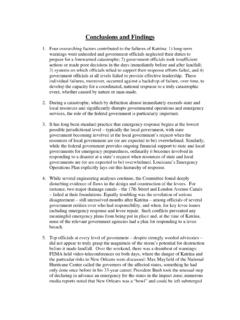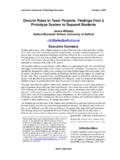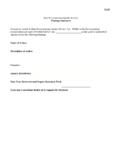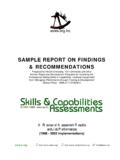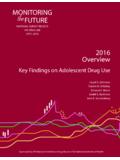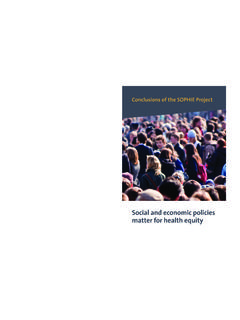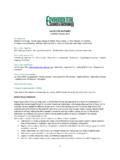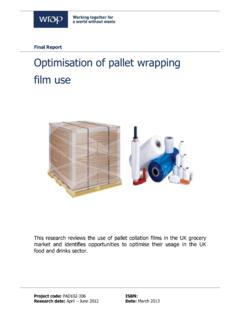Transcription of Economic Importance of Agriculture for Sustainable ...
1 This paper was first presented to the Working Party on Agricultural Policy and Markets, 15-17 November 2010. Reference: TAD/CA/APM/WP(2010)40. Global Forum on Agr iculture 29-30 November 2010 Policies f or Agr icultural Developm ent, Povert y Reduct ion and Food Secur it y O ECD Headquart er s, Par is Economic Importance of Agriculture for Sustainable Development and Poverty Reduction: findings from a Case Study of Ghana Xinshen Diao, IFPRI, 2 3 TABLE OF CONTENTS THE Economic Importance OF Agriculture FOR Sustainable DEVELOPMENT AND POVERTY REDUCTION: findings FROM A CASE STUDY OF GHANA.
2 5 Executive summary .. 5 1. Introduction .. 8 2. Overview of Ghana s Economic 10 Development vision and strategies .. 11 Political, institutional and macroeconomic instability delayed modernization .. 11 Development goals have often been too ambitious .. 13 The earlier strategies did not seek broad-based agricultural development .. 13 Important role of the private sector in industrialization .. 14 3. Position of Agriculture in the current economy .. 16 Ghana s current Economic structure .. 16 Sources of recent Economic growth .. 18 4. Assessing agricultural growth performance .. 19 Assessing agricultural potential in Ghana at national level.
3 19 Assessing agricultural potential in Ghana at farmer level .. 22 5. Agricultural growth and poverty reduction - past experience .. 32 Crop production is the dominant Economic activity and income source for both the poor and non-poor in the rural area .. 33 Differential income patterns across agro-ecological zones .. 36 6. Agriculture s contribution to Economic growth and poverty reduction - an economywide assessment 42 A dynamic computable general equilibrium model .. 43 A social accounting matrix (SAM) for Ghana .. 47 Elasticities and parameters .. 47 Limitations of the DCGE model .. 48 7. Agriculture s contribution to Economic growth and poverty reduction - forward looking scenarios.
4 49 Base-run: Ghana will fail to become an African 'Tiger' by 2020 .. 51 Staples-led growth improves rice import-substitution but not poultry .. 55 Staples-led growth has stronger growth multiplier effects than export-led growth .. 58 Productivity-led growth is possible by closing existing yield 58 Invisible transfers: the most important contribution of Agriculture to overall growth .. 59 Regional impacts of agricultural growth .. 62 Poverty in the North remains at a high level .. 64 8. The role of non-agricultural growth in the forward looking scenarios .. 65 The initial conditions limit the role of industrial growth in Ghana.
5 66 The role of the service sector: lowering service costs for productive sectors is a key .. 72 Agriculture will continue to be a large sector even with rapid growth in non- Agriculture .. 75 9. Conclusions .. 75 REFERENCES .. 80 APPENDIX .. 84 Sensitivity tests .. 87 4 Tables Table 1. Current Economic structure by sector (2007) .. 17 Table 2. Growth decomposition in Ghana .. 18 Table 3. Agricultural TFP growth decomposition in Ghana .. 19 Table 4. Sub-sector contribution to agricultural GDP growth in Ghana .. 20 Table 5. Land expansion and land productivity in Ghana (1994-2006) .. 21 Table 6. Yields of major crops by agro-ecological zone (1994-2005).
6 21 Table 7. Yield gaps in Ghana .. 22 Table 8. Household agricultural landholding and engagement in crop production (Ha hectares) .. 24 Table 9. Number of rural households by landholding size .. 24 Table 10. Number of households reporting crop production .. 25 Table 11. Crop diversification .. 27 Table 12. Input use .. 28 Table 13. Household maize yield and fertilizer use by agro-ecological zone .. 29 Table 14. Household maize yield and herbicide use .. 29 Table 15. Poverty headcount (%), 1991-2006 .. 33 Table 16. Rural households' participation in income-generating activities and share of incomes.
7 34 Table 17. Rural poor and non-poor households' participation in income-generating activities and share of incomes .. 35 Table 18. Households' participation in income-generating activities and share of incomes across zones. 37 Table 19. Poor and non-poor households' participation in income-generating activities across zones .. 39 Table 20. Share of different income sources for the poor and non-poor households across zones .. 41 Table 21. Overview of scenario assumptions .. 50 Table 22. Base-run and accelerated growth scenarios .. 52 Table 23. Sources of GDP growth as in model results (2008-2020) total growth is 100.
8 54 Table 24. Sub-sector level value-added in base-run .. 56 Table 25. Relationship between trade and domestic production/consumption in model results (2020) .. 57 Table 26. Productivity contribution to crop growth in the agricultural growth scenario (2008-2020 average) .. 59 Table 27. Visible and invisible transfers of a financial surplus from Agriculture under the agricultural growth scenario .. 61 Table 28. Agricultural growth across zones under the agricultural growth scenario .. 63 Table 29. Additional sub-sector growth across the four zones under the agricultural growth scenario.
9 63 Table 30. Poverty reduction under the agricultural growth scenario .. 64 Table 31. Growth in household income under the agricultural scenario .. 65 Table 32. Structure of Ghana exports and imports in model results (2020) .. 68 Table 33. Structure of industry and its sub-sectors' contribution to industrial growth in model results .. 69 Table 34. Annual growth in exports and imports in model results (2008-2020 average) per cent .. 70 Table 35. Structure of services and its sub-sectors' contribution to service growth in model results .. 73 Table A1. Sectors/commodities in the Ghana DCGE model .. 84 Table A2.
10 Elasticities in value added, Armington import and CET export functions .. 85 Table A3. Household budget shares and income elasticities .. 86 Table A4. Sensitivity analysis .. 88 Figures Figure 1. Sector share of GDP (1965-2008) .. 16 5 THE Economic Importance OF Agriculture FOR Sustainable DEVELOPMENT AND POVERTY REDUCTION: findings FROM A CASE STUDY OF GHANA1 Executive summary 1. Ghana has become a success story in Africa in the recent years. After more than 20 years' steady Economic growth and significant poverty reduction, Ghana is aiming to become a middle income country in next 10 years. Outcome of transformation in many Asian countries is often characterized by a declined share of Agriculture in GDP and increasingly important role of manufacturing in leading growth in the transformation process.










